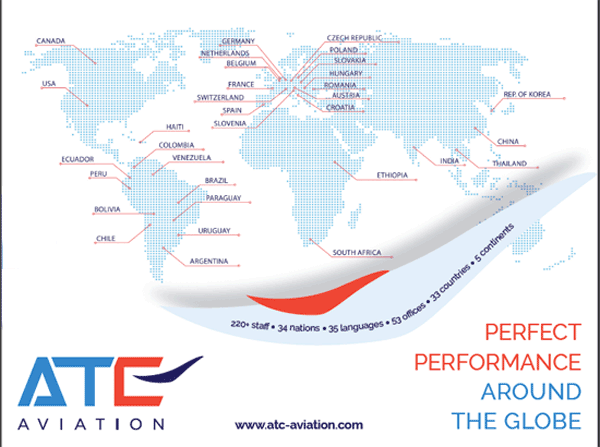
 |
 |
 #INTHEAIREVERYWHERE |
| Vol. 23 No. 26 | Tuesday June 4, 2024 |
| |
 |
 Well, if you want to say Air India is keen
to get back into its prime position as an international cargo player, you
wouldn't be far off.
Well, if you want to say Air India is keen
to get back into its prime position as an international cargo player, you
wouldn't be far off. Plans are underway right now to boost international cargo as Tata Group moves deeper into developing its return in 2021 to owning the airline that was branded Air India in 1946 after JRD Tata (in photo left) and Nevill Vintcent (in photo right) invented Tata Airlines in 1932 as India's first commercial airline. To tell the truth when it comes to the power in the India cargo market, other international cargo carriers have been the prime movers. Almost 90% of the cargo market from India goes via another flag carrier. Figures show that Air India's share of the country's international air cargo stood at about 7%. During fiscal 2023 Air India transported 104,000 metric tons international cargo, while Emirates, Qatar Airways, Cathay Pacific and some others split the bigger piece of the pie. The Air India Air Cargo Outlook 2023, by the India Trade and Transport Group, mentioned, opportunities exist for further freighter fleet growth. Hey, that's a good tongue twister. Further freighter fleet growth, as a driver to support international services, particularly in expanding wide body space. That's what the report said, but not that many times. Air India plans to make the most of its international air cargo opportunities. During the past two years, Air India has added capacity and started new routes and destinations, mostly international, with the enhancement in international connectivity. The carrier is seeing an uptick in cargo. The introduction of widebodies on domestic routes has also seen a significant rise in belly cargo. It must be mentioned that with its sister airline Vistara - TATA SIA Airlines Ltd. flying widebodies to European destinations like London Heathrow, Paris and Frankfurt, there's been a substantial increase in international air cargo. For its part, Air India has been focusing on Delhi, which has become its cargo hub connecting the U.S., Canada, Europe and Australia. The hub is serviced by bonded cargo services arriving at the airport from all regions by road and air. Air India management has adopted a proactive approach to tie up with bonded truckers and hatched a level of efficiency that has landed a rise in outbound cargo loads from Delhi. The bonded truck services started with nine routes, which will ultimately be enhanced to 200. Air India has recently tied up with Interline partners to key markets in the United States adding to the bonded services. Additionally the carrier recently partnered up with Envirotainer for pharma containerization and now is moving full throttle into building services into that vital offering for air cargo. Tirthankar Ghosh |
|
|
CONFETRA in Rome sent me an interesting report on the state of air cargo in Italy. For me this was a great opportunity to read some comforting numbers from my home country, albeit with some alarming signs. This gave me reason to take contact with some of our friends around the world to understand difference and similarities, through a series of short statements regarding the state of air cargo in their respective areas.  Let
me start, considering his position at the helm of TIACA, with Glyn Hughes.
Regarding the current industry performance Glyn said that “we
have now experienced five consecutive months of double digit year over performance
increase in demand. Some of this is attributed to easing global economic
conditions, some to a weak Q1 in 2023, some to the continuing strength of
ecommerce and some to the continuing challenges being experienced in the
maritime sector with Red Sea avoidance. There are however other factors
at play: e-Commerce demand from China is very strong with high demand to
USA, Latin America and Europe. African demand for inbound and outbound cargo
is strong. Indian exports remain very strong and this is also resulting
in high demand for air cargo.” Glyn also disclosed his expected
trends throughout 2024: “Indications from maritime operators suggest
that avoidance of Red Sea will continue for the next few months at least.
With the extra 10/14 days sailing times from Asia to Europe this will keep
air cargo demand in prime focus. Maritime costs are also higher, which keeps
the differential to air cargo closer and thus further encourages air cargo
usage. On the other hand, e-commerce demand is expected to remain high throughout
the year and indications are already starting to suggest that Q4 demand
will be very strong and capacity may be in short supply.” Let
me start, considering his position at the helm of TIACA, with Glyn Hughes.
Regarding the current industry performance Glyn said that “we
have now experienced five consecutive months of double digit year over performance
increase in demand. Some of this is attributed to easing global economic
conditions, some to a weak Q1 in 2023, some to the continuing strength of
ecommerce and some to the continuing challenges being experienced in the
maritime sector with Red Sea avoidance. There are however other factors
at play: e-Commerce demand from China is very strong with high demand to
USA, Latin America and Europe. African demand for inbound and outbound cargo
is strong. Indian exports remain very strong and this is also resulting
in high demand for air cargo.” Glyn also disclosed his expected
trends throughout 2024: “Indications from maritime operators suggest
that avoidance of Red Sea will continue for the next few months at least.
With the extra 10/14 days sailing times from Asia to Europe this will keep
air cargo demand in prime focus. Maritime costs are also higher, which keeps
the differential to air cargo closer and thus further encourages air cargo
usage. On the other hand, e-commerce demand is expected to remain high throughout
the year and indications are already starting to suggest that Q4 demand
will be very strong and capacity may be in short supply.” In
thanking our friend Glyn Hughes for his expert comments, let me now turn
to the Chairperson of the FIATA Airfreight Institute, Dawit Woubishet, who
is also Director of WoubGet Holdings. This is his statement, which is meant
to cover the vast area Africa Middle East, i.e. the area of the world which
holds the right numbers in terms of population and resources to get a leading
position in our future. This is Dawit’s statement: “The
air cargo industry in Africa and the Middle East is experiencing growth
and evolution driven by various factors such as economic development, infrastructure
improvements, and changing market dynamics. With the increasing demand for
fast and reliable delivery of goods, e-commerce has been relying highly
on air cargo services. Thus leading airlines to form partnerships and alliances
with other carriers to expand their reach. Following this, governments in
these regions have been trying to modernize custom processing, improve security
measures and enhance the air cargo infrastructure. Continued investments
in infrastructure and technology are expected to further enhance the efficiency
and competitiveness of air cargo operations in these regions.”
This is in fact a pretty positive message and in a nutshell it contains
the seeds for the future development of this region. In
thanking our friend Glyn Hughes for his expert comments, let me now turn
to the Chairperson of the FIATA Airfreight Institute, Dawit Woubishet, who
is also Director of WoubGet Holdings. This is his statement, which is meant
to cover the vast area Africa Middle East, i.e. the area of the world which
holds the right numbers in terms of population and resources to get a leading
position in our future. This is Dawit’s statement: “The
air cargo industry in Africa and the Middle East is experiencing growth
and evolution driven by various factors such as economic development, infrastructure
improvements, and changing market dynamics. With the increasing demand for
fast and reliable delivery of goods, e-commerce has been relying highly
on air cargo services. Thus leading airlines to form partnerships and alliances
with other carriers to expand their reach. Following this, governments in
these regions have been trying to modernize custom processing, improve security
measures and enhance the air cargo infrastructure. Continued investments
in infrastructure and technology are expected to further enhance the efficiency
and competitiveness of air cargo operations in these regions.”
This is in fact a pretty positive message and in a nutshell it contains
the seeds for the future development of this region.  Within FIATA I had the opportunity to talk
with Paul Golland, Vice Chair IFCBAA and immediate past Chair of FAPAA.
Paul is also a Member of FIATA’s Extended Board, the body that was
designed to coordinate the federation’s policy issues. I am particularly
happy to have Paul’s views, because Australia is indeed an essential
component of the air cargo industry, where the competitive advantages of
air transport are underlined by the existence of a large landmass that is
far from Europe, Africa and America. This is how Paul describes the situation
of the local air cargo market: “the Australian airfreight market
has rebounded well since Covid. The domestic airfreight market has just
surpassed passenger numbers and cargo carried pre-Covid. We have recently
lost a small airline, Bonza, which handled some small routes and are now
very much back to the major two airlines Qantas and Virgin. Internationally
our capacity is increasing as tourists return to Australia. This is very
important to us as over 90% of all cargo arrives on passenger aircraft.
We are very close to pre-Covid numbers as well. All airlines that came to
Australia pre-Covid are back almost to the same number of flights. We are
also interested in seeing the introduction of a global air programme as
Australia and the Asia Pacific region in general has been left behind in
relations with the airlines. We are still very much in an agent position
instead of principal to principal relationship. This needs to change if
we are to implement important changes such as sustainability and digitalisation
of the industry.”
Within FIATA I had the opportunity to talk
with Paul Golland, Vice Chair IFCBAA and immediate past Chair of FAPAA.
Paul is also a Member of FIATA’s Extended Board, the body that was
designed to coordinate the federation’s policy issues. I am particularly
happy to have Paul’s views, because Australia is indeed an essential
component of the air cargo industry, where the competitive advantages of
air transport are underlined by the existence of a large landmass that is
far from Europe, Africa and America. This is how Paul describes the situation
of the local air cargo market: “the Australian airfreight market
has rebounded well since Covid. The domestic airfreight market has just
surpassed passenger numbers and cargo carried pre-Covid. We have recently
lost a small airline, Bonza, which handled some small routes and are now
very much back to the major two airlines Qantas and Virgin. Internationally
our capacity is increasing as tourists return to Australia. This is very
important to us as over 90% of all cargo arrives on passenger aircraft.
We are very close to pre-Covid numbers as well. All airlines that came to
Australia pre-Covid are back almost to the same number of flights. We are
also interested in seeing the introduction of a global air programme as
Australia and the Asia Pacific region in general has been left behind in
relations with the airlines. We are still very much in an agent position
instead of principal to principal relationship. This needs to change if
we are to implement important changes such as sustainability and digitalisation
of the industry.” The
only area which is close to Australia in terms of flown miles is Asia-Pacific,
of which Australia technically is part: interesting to register the state
of the industry as perceived in a key area within Asia, the Indian subcontinent.
Who else could send us such comments, other than Keshav Tanna, the former
chairperson of FIATA’s Air Freight Institute, who speaks here as Member
of the Federation of Asia Pacific Air Cargo Associations ( FAPAA): “The
Asia Pacific region is and has been the most potential Air Cargo sector
for many years now. AsiaPac has over 30% of global market share in the Air
Cargo market and continues to grow in double digit figures in terms of CTK
(Cargo tonne Kilometres). Today’s business environment is surely not
conducive to the principal/agent relationship and is more of a customer/service
provider relationship in terms of buying and selling cargo space, which
is what today’s forwarders are in effect doing. However, for some
reason this promising market has thus far been eluded/secluded unlike its
western colleagues, who enjoy a far more collaborative relationship with
their airline partners in terms of an equitable partnership air cargo program
that recognises the current business environment of a forwarder being a
customer of the airline rather than its agent. It would be heartening for
the AsiaPac forwarders to be treated as equals, just like the forwarders
in other parts like Europe and Canada, where applications of resolutions
are far less stringent than those in Asia Pacific. Global Associations have
hence taken it upon themselves to push for a Global Air Cargo program which
would be more conducive to today’s business environment and would
be more equitable, unlike the current fragmented programs, which are unfortunately
legacy programs formulated many decades ago and not fit for purpose any
longer. We are hopeful that going ahead AsiaPac forwarders would get this
equal recognition like their colleagues in other parts of the World.” The
only area which is close to Australia in terms of flown miles is Asia-Pacific,
of which Australia technically is part: interesting to register the state
of the industry as perceived in a key area within Asia, the Indian subcontinent.
Who else could send us such comments, other than Keshav Tanna, the former
chairperson of FIATA’s Air Freight Institute, who speaks here as Member
of the Federation of Asia Pacific Air Cargo Associations ( FAPAA): “The
Asia Pacific region is and has been the most potential Air Cargo sector
for many years now. AsiaPac has over 30% of global market share in the Air
Cargo market and continues to grow in double digit figures in terms of CTK
(Cargo tonne Kilometres). Today’s business environment is surely not
conducive to the principal/agent relationship and is more of a customer/service
provider relationship in terms of buying and selling cargo space, which
is what today’s forwarders are in effect doing. However, for some
reason this promising market has thus far been eluded/secluded unlike its
western colleagues, who enjoy a far more collaborative relationship with
their airline partners in terms of an equitable partnership air cargo program
that recognises the current business environment of a forwarder being a
customer of the airline rather than its agent. It would be heartening for
the AsiaPac forwarders to be treated as equals, just like the forwarders
in other parts like Europe and Canada, where applications of resolutions
are far less stringent than those in Asia Pacific. Global Associations have
hence taken it upon themselves to push for a Global Air Cargo program which
would be more conducive to today’s business environment and would
be more equitable, unlike the current fragmented programs, which are unfortunately
legacy programs formulated many decades ago and not fit for purpose any
longer. We are hopeful that going ahead AsiaPac forwarders would get this
equal recognition like their colleagues in other parts of the World.” Let
us now travel to Europe, which – as Keshav suggested – used
to benefit from a more equitable relationship with the airlines. Nicolette
van der Jagt, DG of CLECAT, tells us what is the European sentiment in this
period: “The European, like the global air freight market, has
been quite buoyant since the beginning of the year. The strong global air
freight market is driven by two main developments: a surge of e-commerce
volumes and the Red Sea situation affecting traders in the world. As a consequence
of this, there have been a bit less longer-term agreements - so we see a
more volatile environment, with rates going up, and shippers and forwarders
extending decisions for contract agreements and the majority of contracts
being less than 3 months. At the same time, we see carriers and forwarders
seeking to find agile solutions to respond to changing positions. In Europe
we note that the rising ocean freight rates (with a lack of capacity and
containers) correlate with airfreight demand. As the Red Sea situation and
the ocean disruptions are likely to last for some time, this market situation
will remain. The good news is that capacity will be stronger over the summer
because of more passenger flights coming in.” In her usual effective
and concise manner Nicolette has given us the entire picture in a few lines. Let
us now travel to Europe, which – as Keshav suggested – used
to benefit from a more equitable relationship with the airlines. Nicolette
van der Jagt, DG of CLECAT, tells us what is the European sentiment in this
period: “The European, like the global air freight market, has
been quite buoyant since the beginning of the year. The strong global air
freight market is driven by two main developments: a surge of e-commerce
volumes and the Red Sea situation affecting traders in the world. As a consequence
of this, there have been a bit less longer-term agreements - so we see a
more volatile environment, with rates going up, and shippers and forwarders
extending decisions for contract agreements and the majority of contracts
being less than 3 months. At the same time, we see carriers and forwarders
seeking to find agile solutions to respond to changing positions. In Europe
we note that the rising ocean freight rates (with a lack of capacity and
containers) correlate with airfreight demand. As the Red Sea situation and
the ocean disruptions are likely to last for some time, this market situation
will remain. The good news is that capacity will be stronger over the summer
because of more passenger flights coming in.” In her usual effective
and concise manner Nicolette has given us the entire picture in a few lines. This
collage of opinions becomes more and more meaningful as we come to meet
the speakers presenting their views. In a conversation with Mike White,
President, Trade Network Consultants, whom we all know also from his former
role in CNS and his precious contribution to PayCargo and the Florida International
University we heard a comprehensive picture about North America. This
collage of opinions becomes more and more meaningful as we come to meet
the speakers presenting their views. In a conversation with Mike White,
President, Trade Network Consultants, whom we all know also from his former
role in CNS and his precious contribution to PayCargo and the Florida International
University we heard a comprehensive picture about North America. These are his knowledgeable comments: “In the dynamic world of global commerce, the air cargo industry serves as a vital artery, facilitating the swift movement of goods across continents. In North America, home to bustling economic hubs and thriving e-commerce markets, the air cargo sector has weathered storms and soared to new heights. As we delve into the latest developments and trends shaping this industry, a compelling narrative of resilience, adaptation, and innovation unfolds. “The past year has been a testament to the resilience of the North American air cargo industry. Despite the disruptive impact of the COVID-19 pandemic, the sector has witnessed a remarkable stabilization, with cargo volumes returning to pre-pandemic levels. However, major carriers such as American Airlines Cargo and Delta Cargo have faced revenue declines, highlighting the challenges posed by fluctuating demand and operational constraints. “In response to evolving market dynamics, integrator carriers like UPS and FedEx have embarked on strategic transformations. With a focus on efficiency and modernization, these industry giants are leveraging innovative solutions to optimize their networks. FedEx, in particular, has shifted towards utilizing more capacity on scheduled passenger flights while streamlining its business units. Despite setbacks such as the loss of the U..S Postal Service contract by FedEx, integrators remain at the forefront of innovation, ushering in a new era of air cargo logistics. “The landscape of North American manufacturing is undergoing profound changes, with on-shoring and near-shoring gaining traction. As companies reassess their supply chains in the wake of global disruptions, Mexico emerges as a focal point for manufacturing relocation. This trend is mirrored in the aviation sector, with increased freighter and passenger wide-body services to Mexico from prominent carriers like Air Canada Cargo and Lufthansa Cargo. These developments underscore the resilience and adaptability of the air cargo industry in response to shifting economic paradigms. “The exponential growth of e-commerce continues to propel the demand for air cargo services in North America. Small e-commerce shippers, in particular, are driving this surge, leveraging air transport to meet consumer demands for speedy deliveries. However, challenges persist, especially in markets like Mexico, where currency issues pose logistical hurdles for international sellers. As the e-commerce landscape evolves, stakeholders are exploring innovative solutions to enhance cross-border trade and address emerging challenges. “Regulatory considerations loom large on the horizon, with policymakers deliberating changes to customs clearance procedures and duty exemptions. The proposed reduction in de-minimis values for customs clearance reflects ongoing efforts to streamline trade processes and enhance security measures. “Meanwhile, the U.S. government's focus on combatting the illicit transport of fentanyl underscores the critical role of regulatory enforcement in safeguarding supply chains and protecting public health. “As the North American air cargo industry charts its course through turbulent skies, one thing remains abundantly clear: resilience is woven into the fabric of this sector. From adapting to market fluctuations and embracing technological innovations to navigating regulatory complexities, industry stakeholders continue to demonstrate unwavering determination and ingenuity. As we look towards the horizon, the future of air cargo in North America shines bright, guided by the pioneering spirit of those who dare to soar.”  If
I go back now to my home country and the study released by CONFETRA, let
me register the introduction given by the President of Confetra, Carlo De
Ruvo: “Air Cargo transport today is facing various challenges,
ranging from the green transition to the definition of new cargo mobility
routes. The international geopolitical situation, with the Red Sea crisis
and the resulting difficulties in maritime transport, has brought air cargo
to the headlines. In Italy in particular this sector is strategic for exports
and more generally for the national economy and needs expert policies to
make it more competitive concerning market requirements, also by offering
ground services in line with the nature of airborne transportation: efficiency,
speed, reliability and safety. The current phase, with the new National
Airport plan being discussed, can be a precious opportunity to contribute
to a relaunch.” If
I go back now to my home country and the study released by CONFETRA, let
me register the introduction given by the President of Confetra, Carlo De
Ruvo: “Air Cargo transport today is facing various challenges,
ranging from the green transition to the definition of new cargo mobility
routes. The international geopolitical situation, with the Red Sea crisis
and the resulting difficulties in maritime transport, has brought air cargo
to the headlines. In Italy in particular this sector is strategic for exports
and more generally for the national economy and needs expert policies to
make it more competitive concerning market requirements, also by offering
ground services in line with the nature of airborne transportation: efficiency,
speed, reliability and safety. The current phase, with the new National
Airport plan being discussed, can be a precious opportunity to contribute
to a relaunch.”CONFETRA’s document mainly regards the Italian market, but it draws interesting parallels within Europe and even further. Let me just mention what I find most interesting in the relatively short read: “Air freight transport has embarked on a recovery path, but in the medium-long term a gradual increase in prices might kick-in. In 2023 goods handled at Italian airports exceeded one million tonnes, recording a slight reduction compared to 2022, with a predominant freight share (96%) compared to mail (4%), Milan Malpensa by far being the dominant hub, but slightly declining (-6.85) against Rome, which is worth about 1/3, yet its volumes increased by 35%. From a territorial point of view, the main exporting regions are located in northern Italy, in fact with as much as 63% of exports in value coming from four regions: Lombardy (26%), Emilia-Romagna (14%), Veneto (13%) and Piedmont (10%). At a European level, Italy is second just after Germany (27.9%) in non-EU trade, with a percentage of 11.9% and ahead of France (10.5%). Non-EU goods moved by air stand at 67% on the export and 33% import sides respectively. If we talk of infrastructure the picture is not the same: Italy is indeed second in terms of non-EU export volumes, but Italian airports are just fifth in this ranking behind Germany (36%), France (15%), Belgium (12%) and the Netherlands (11%).” My personal comment to this elementary comparison is perhaps a bit dry: it is the sad result of insufficient investments in infrastructure, and this is not limited to airports unfortunately: the list of missed opportunities is long . . . Regarding the prospects for global air transport, Italians think that “air cargo is an innovative sector capable of seizing the opportunities deriving from the health and geo-political crises and the evolution of the market. Its growth can be ascribed both to the ability to respond quickly to market demands and the resilience after recent crises.” In particular, it was noted that China is showing important sectoral responses. Chinese fast-fashion giants move the equivalent payload of 108 Boeing 777 aircraft every day. Obviously this is an opportunity as well as a threat: “current capacity is insufficient, transport costs may increase, trade is not balanced and some operators are trying to create their own fleets, cutting slices within the market. An overall 13% increase was recorded in the first two months of 2024, compared to the same period in 2023. Overall air freight capacity in the world is increasing compared to 2023 (+9%), in particular for traffic from Asia Pacific (+14%) and Central and South America (+14%). IATA data also shows an increase in global demand (in terms of tonnes/km); for the third consecutive month there has been a double-digit increase (February 2024 +12.4% in the international market).” The environment plays a significant role in Confetra’s study, as a direct consequence of political choices taken at EU level, as the EU is the first region in the world to establish a regulatory framework that will promote sustainable aviation fuels. In this CONFETRA shows a different approach: all other positions echo one another, drawing a rather positive picture of today’s air cargo, but CONFETRA also correctly looks at possible uncertainties and reminds us that huge investments are required. As a matter of interest, McKinsey recently drew investors’ attention toward SAF. Confetra is however more specific. “Decarbonisation naturally does not end with the use of biofuels, a series of initiatives involve the entire supply chain, from the technological development of aircraft to zero-impact airports. The European Parliament estimates that, between 2020 and 2050, significant investments of 378 billion euros would be needed to replace aircraft and introduce new technologies, for which research and development (R&D) activities are expected to cost 50 billion euros, while the overall costs of decarbonisation measures should amount to around 33 billion euros.” These estimates actually appear optimistic, the Royal Netherlands Aerospace Centre estimates at least 820 billion euros of additional investments would be needed in the period 2018-2050. Confetra concludes that “the green transition process of the aviation sector must be managed optimally and gradually, so that it does not backfire in terms of reducing emissions and socio-economic impacts.” Additional points struggle to find suitable solutions: slow procedures create idle time on the ground, admins are not always coordinated and disparity between express and general air cargo persists. Insufficient uptake of AEO and digitalisation is a further element of weakness, together with inadequate intermodal connections: in the end that study concludes that Italy does not seem to have a clear picture for its future with a “lack of a long-term strategic vision”. As I said in the beginning, in Italy strong development together with some alarming signs compose the image we are looking at. For one reason or another the country does not appear to be optimistic.  Other
pictures are not so grey though: our next and last contributor carries a
more hopeful message, and is in line with the other findings that we have
just listed. Looking at Central and South America Jorge Guillermo Heinermann
is 2nd Vice Chair of ALACAT, Chair of LAACPJC (IATA REGION AMERICA), Chair
of FIATA’s Region Americas . . . and our next speaker. Jorge is based
in Buenos Aires and for a number of years Jorge and I met at FIATA’s
events, but he is with us today at the FlyingTypers: “Latin
America stands out as the region experiencing the most substantial growth
in global air cargo traffic. This growth has spurred an increase in shipments
to Europe, driven not only by direct cargo destined for Europe, but also
by significant transit traffic to Asia and Africa. Madrid airport emerges
as the preferred hub for facilitating these services. While perishable goods
like fruits, vegetables, flowers, meats, and fish dominate the shipments,
industrial products have also seen a surge in transportation. Other
pictures are not so grey though: our next and last contributor carries a
more hopeful message, and is in line with the other findings that we have
just listed. Looking at Central and South America Jorge Guillermo Heinermann
is 2nd Vice Chair of ALACAT, Chair of LAACPJC (IATA REGION AMERICA), Chair
of FIATA’s Region Americas . . . and our next speaker. Jorge is based
in Buenos Aires and for a number of years Jorge and I met at FIATA’s
events, but he is with us today at the FlyingTypers: “Latin
America stands out as the region experiencing the most substantial growth
in global air cargo traffic. This growth has spurred an increase in shipments
to Europe, driven not only by direct cargo destined for Europe, but also
by significant transit traffic to Asia and Africa. Madrid airport emerges
as the preferred hub for facilitating these services. While perishable goods
like fruits, vegetables, flowers, meats, and fish dominate the shipments,
industrial products have also seen a surge in transportation.“In response to ongoing global shifts, trials of fully electronic processes, eliminating the need for physical documentation, have emerged. The successful execution of a digitalized export operation, from origin to internationalization via import to Europe through Madrid airport, marks a significant milestone. This testing, conducted with the support of Customs authorities from Peru and Uruguay, underscores the seamless transition towards digitalization. ALACAT has been instrumental in promoting these advancements. Our region remains committed to sustainable practices, fostering collaboration among various stakeholders, and advancing the digitalization of processes with both local and international partners.” Jorge’s statement exudes optimism for the future as well as an appropriate degree of satisfaction for the results achieved by his productive community. The collective picture we were given is nonetheless rather positive and it tells us that the industry has managed to resurrect itself from its own ashes after the pandemic, which hit aviation probably harder than many other industries. This is a strong indication of resilience and, if we manage to retain lessons from what we went through, an indication of a roadmap that merely needs to be tailored as required by circumstances. Leaving our readers with some positive thoughts gives me much joy. Were it not for the fact that some of the positive remarks of this repertoire were also registered as a reaction to tensions rising in neighbouring areas, e.g. the situation of the Red Sea, I would certainly reflect on the positive condition of the state of Air Cargo without hesitation. Are there doubts that the world is enjoying a peaceful and prosperous period? The stock exchange is buoyant. Perhaps prosperous for many more of us than in the past, peaceful it certainly isn’t, unfortunately . . .There is room for improvement. As we have done in the best periods of our lives, let us focus on what unites us and carry on. Marco L. Sorgetti |
 |
 |
If
You Missed Any Of The Previous 3 Issues Of FlyingTypers Access complete issue by clicking on issue icon or Access specific articles by clicking on article title |
||
 Vol. 23 No. 23 ICAO Cargo Action Peru Bob Arens Is Fondly Remembered |
 Vol. 23 No. 24 AmidSpring's Day Dream Chuckles for May 14, 2024 Where Are They Now |
|
Publisher-Geoffrey Arend • Managing
Editor-Flossie Arend • Editor Emeritus-Richard Malkin |
Send comments and news to geoffrey@aircargonews.com
|